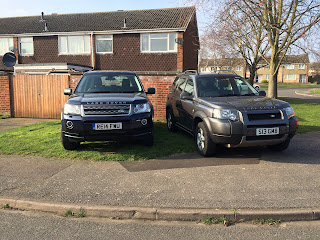In 1989 Land Rover launched the original Discovery model. Based heavily on the Range Rover it was intended as a "lifestyle" vehicle, and had a bright blue interior designed by Conran. Times change and the Discovery has matured in to a more traditional and up-market 4x4; now, twenty-seven years on, the current Discovery is coming to the end of production with its replacement due later this year.
Although branded as Discovery 4, it's arguably only the second generation as the original and Series II versions were mechanically very similar, and the Discovery 4 is an evolution of the Discovery 3, which was launched in 2004, using the same body and chassis but with a more upmarket interior, and the engines have also evolved and improved during production.

The exterior design is striking, and there is little else on the road that looks like it. I remember seeing the original press photos of the Discovery 3 and being unsure as to whether I like it or not, and even now I'm still not sure. The shape of the rear window is designed to echo the design of the previous Discovery, which had its spare wheel mounted on a side-opening rear door. As the Discovery 3's rear door is a split Range Rover style up-and-down tailgate, with the spare wheel slung underneath, I can't help feeling that it looks a little awkward, as though the designers included it for a reason they couldn't quite recall, or perhaps because "we've always done it that way".
As a result, I've always thought the rear design was crying out for a spare wheel to be mounted there, and needless to say there are third-party accessory manufacturers who have products to let you do just that.
The square, vertical theme continues inside and also feels a bit dated despite having evolved during its production; which might be part of the problem as different features and styles of control have been fitted or modified, and have moved around the console at various points.
The version I have been driving is the Landmark, one of two versions currently available; the other being the lower specification Graphite. All UK models are fitted with a 3.0 SDV6 Euro 6 engine and an eight-speed automatic gearbox, height adjustable air suspension, high and low range transfer box and locking centre diff with Land Rover's excellent Terrain Response system (the Discovery 3 was the first to be fitted with it).
Climbing aboard, the Landmark's Windsor leather seats are supremely comfortable, if a little narrow. They adjust electrically in almost every possible way, with separate front and rear height adjustment, lumbar support, fore and aft and of course seat back rake. The bolsters can also be adjusted in or out to support you laterally. Adjustment of the steering wheel is also electrical, and with the memory pack once you've found your ideal seating position the car will return to it at the touch of a button, including your preferred exterior mirror settings.

The instrument panel will be familiar if you have driven almost any recent Land Rover (apart from Defender). An electronic screen sits between the speedometer and rev counter and shows engine temperature and fuel, plus a plethora of other information. However, unlike the screen in my Freelander 2 and Discovery Sport, the screen is monochrome and fairly low resolution, but the information is presented clearly and includes sat nav directions which is helpful.
A lot of the controls look and feel familiar from Freelander 2 and other Land Rovers, but with some inconsistencies such as the headlights being controlled via a knob on the dashboard instead of the stalk. The Discovery 3 was designed during the Ford era, and I knew I'd heard the indicator tick-tock somewhere before: in a Ford Transit. This is an observation; not a criticism.

Details aside, with the engine running the cabin is a very calm place to be. There's plenty of sound insulation so the engine is well muted, and you can chose your own audio accompanyment from the Meridian sound system which includes a TV, DAB radio and an iPod connection. I lost count of the number of speakers around the cabin, but the sub certainly makes its presence felt. Rear seat passengers have their own screens mounted in the back from the front seat head restraints, and an infrared remote control allows them to control the system from there too.

On the subject of the rear seats, there are three separate rear (second row) seats that can be folded individually either flat for additional load space or rolled forward for access to the third row seats. Discovery 4 is a full seven-seat vehicle, and even full-sized adults can sit comfortably in the rearmost seats. Those third row seats fold flat in to the floor of the boot when not required, although they are a little fiddly to deploy and stow. With the seats stowed the boot space is cavernous, and I can't reach far enough in to the car from the drop-down tailgate to touch the second row of seats. There is also a pair of cubby holes in the boot for small oddments, and a large space behind the rear trim, although this is not lined so you won't want to put anything sharp or solid in there as it'll rattle or damage the metalwork.

As with several other Jaguar Land Rover vehicles, the gear selector rises out of the centre console when you start the engine. Turning it to Drive and pressing the accelerator releases the electric parking brake (with a bit of a judder) and you are on your way. There's no denying that it is a heavy vehicle, but it still manages to have reasonable performance and the air suspension deals with body-roll very well indeed for something so tall.
I haven't had the opportunity to take this car off road, but I did try a Discovery 4 at the Land Rover Experience in 2010 and its off-road credentials are well deserved. Even on road tyres the wet, muddy and slippery conditions didn't seem to cause it any concern, and the Terrain Response system combined with Hill Descent Control were far better at maintaining control than the human behind the wheel. With the air suspension in off-road mode the wading depth of the Discovery 4 is 700mm, and should you run out of ground clearance the system will detect this and give you an extra inch to be able to reverse out again.

At the other end of the scale, the air suspension can be lowered in the Access Mode to help you slip under height bars or in to multistory car parks. Or just to help you get in and out of the car.
On road there is a floatyness to the ride that might cause some people a degree of motion-sickness, but it stays well away from wallowey, and even on moderately twisty B-roads the Discovery 4 remained composed. In terms of performance it's obviously no sportscar, but I was able to hustle it
around the Milton Keynes roundabout obstacle course with enthusiasm, and it certainly held its own against a couple of executive saloons - but the fuel economy really doesn't appreciate that sort of behaviour. That said, on a cross-country run involving a mixture of A and B-roads with some dual-carriageway work I managed to achieve an average of 30mpg.

A relatively recent addition the Discovery 4 is stop-start, ostensibly to improve economy and reduce emissions. It works on the brake, and as you come to a halt the engine stops, bursting back in to life as you lift your foot off and back to the accelerator. Overall it works well, although there is a noticable, almost intrusive, shudder on restart. Another measure to improve its emissions is the addition of "diesel exhaust fluid" (AKA AdBlue), which reduces the nitrogen oxide emissions.
There are other disappointments around the car in terms of fit and finish. Both the driver's door and the upper portion of the tailgate are reluctant to close and need a firm hand. And frequently a second attempt. There is a large plastic unit, containing the alarm sensors, mounted on the ceiling which rattles; putting a hand on it stops it. This is a £54k car: doors should close easily and there should not be rattly plastic alarm sensors.
It is undoubetdle an impressive vehicle, but one that is all too obviously reaching the end of its production life. It is the last of the square-era Land Rovers and parked alongside its newer siblings it looks slightly awkward and out of place. Whatever comes next in Discovery 5 will be well worth looking at, and I hope to get the opportunity to drive and review in due course.
Having recently bought a Discovery Sport I did seriously consider the Discovery 4, but I simply don't need something that large. Having had a week with a Discovery 4 did I make the right decision in buying the Sport? Yes.

























